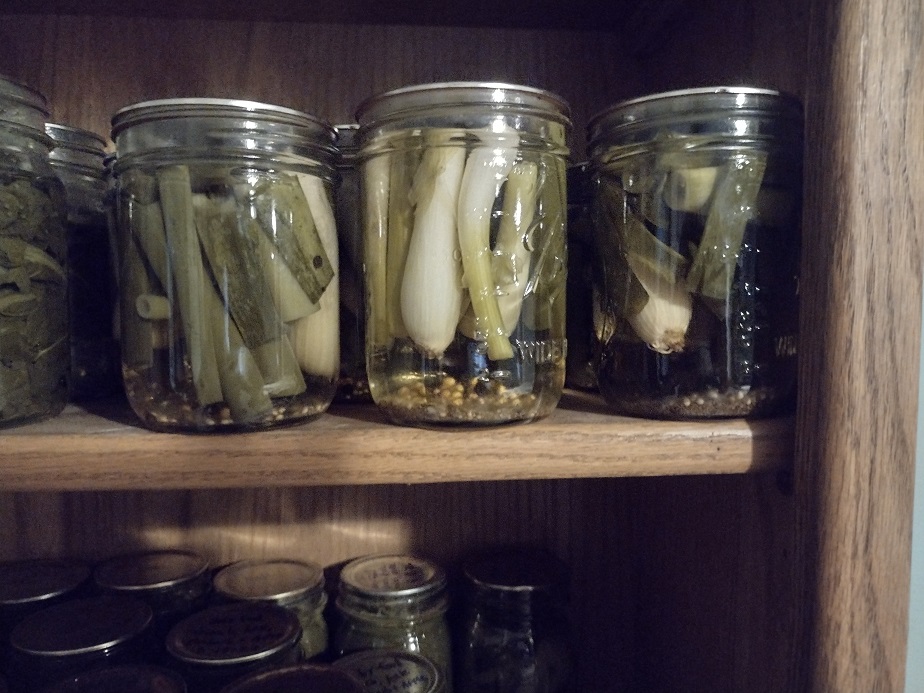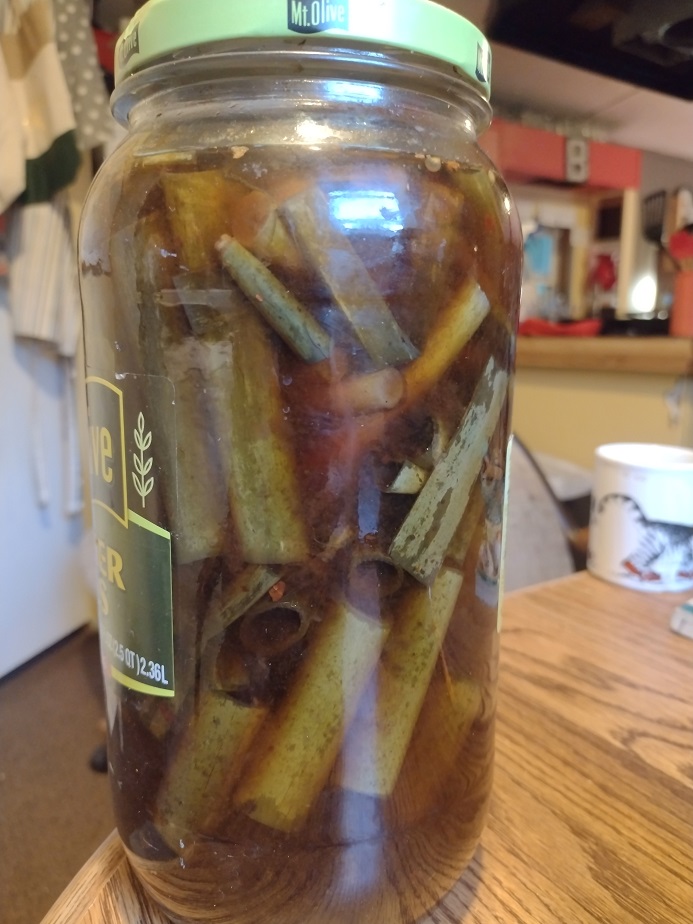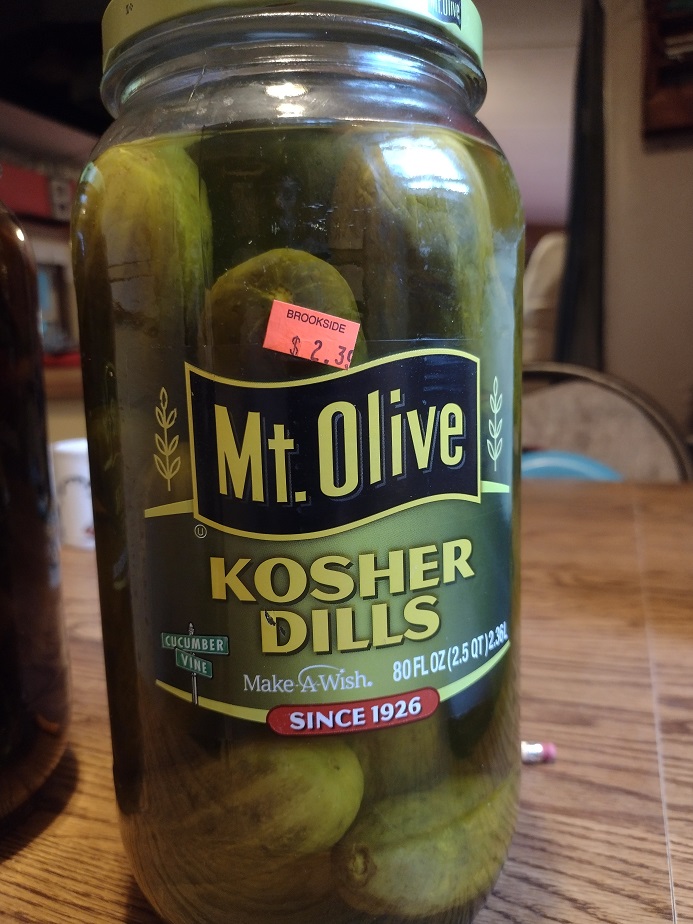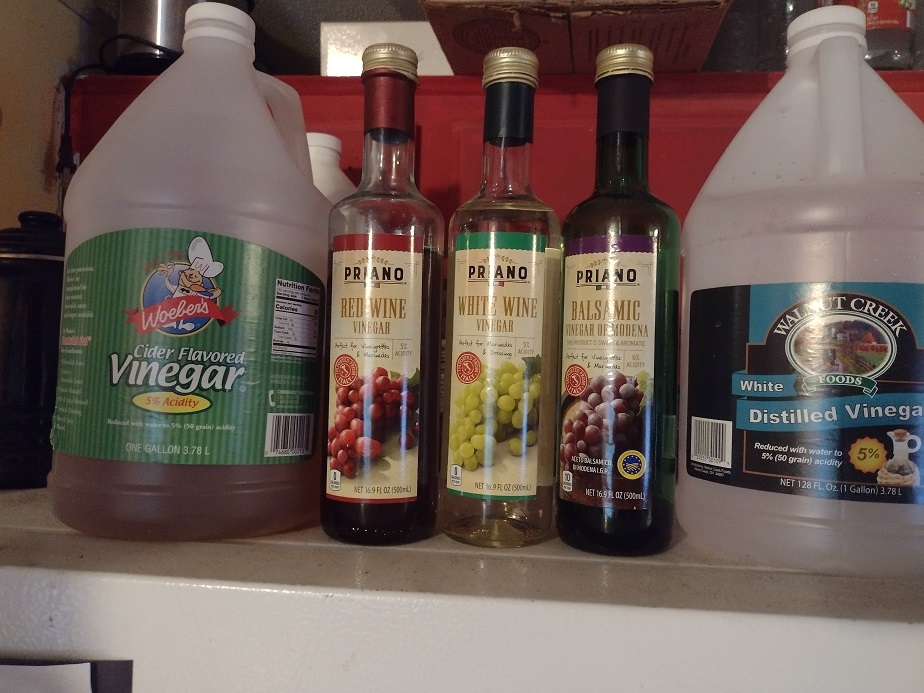We include vinegar in our long-term preps because it’s one of the most useful kitchen ingredients on a homestead.
To store vinegar long-term, keep it unopened in a cool, dark location. Vinegar can remain viable for a lifetime but will lose some quality after 3 years. Oxegen, heat, and sunlight will break down the acetic acid in vinegar but stored properly it will remain shelf-stable for a very long time.
Here’s how we store vinegar, and how we use it around the homestead.
Storing Vinegar Without it Going Funky
Vinegar has been a staple of food preservation as far back as 5,000 B.C. It’s used for health benefits, disinfecting, flavoring, and most importantly as a safe food preservative. It can last a long time, but it certainly can get funky and taste weird.
As a kid, we had an ancient barrel of vinegar in the pantry. It was rarely used, mostly in the traditional boiled red cabbage and apples that I loved so much. That vinegar hung around for way too long, and just kinda turned. Colored vinegar loses its flavor and ends up tasting “off’ after 2-3 years or so.
As a kid, the cider vinegar was stored great, (in a cool, dark, basement pantry) it was just so seldom used that it hung around for years and just wasn’t the same anymore. But, it was still a safe, shelf-stable product with the same acidity level. That’s why mom kept it around.
In my household, we don’t let anything sit around that long unless it’s designated for long-term storage. Those are things we don’t open until an undesignated dire circumstance. So yes, it may be there a while. If you want to store a vinegar that won’t change the taste, get a distilled white vinegar.
Any vinegar with color, an undistilled vinegar, will change flavors with time as compounds in the vinegar break down with age. All vinegar will remain safe if stored properly, so that’s not the concern. Personally, I’m alright with cider vinegar that tastes “off” because it still tastes better than distilled vinegar to me.
If you want to stash away some vinegar for potential food preservation or as an emergency cleaning solution, either type will do. Distilled vinegar tends to be a tad stronger (lower pH) than undistilled vinegar.

How Does Vinegar Preserve Foods?
Vinegar preserves foods by creating a high-acid environment that won’t allow the growth of mold or bacteria. Foods below a pH of 4.6 are considered safe and not prone to spoilage, but most pickled goods have a pH between 3 and 3.6 to prevent mold and ensure that it’s well within the safety standard.
Pretty much all vinegars have a pH between 2.5 and 3. Distilled white vinegar is usually closer to 2.5-2.6, and cider vinegar is more like 2.7-3. Any vinegar can be used as a preservative. Even though different vinegars have different strengths, they’re quite interchangeable in pickling recipes.
In food preservation, there’s one group of bacteria that causes the most alarm. That is a group of deadly Anaerobic bacteria. Anaerobic means without oxygen. The common theme with all of these deadly creatures is that they can only live in a low-oxygen, low-acid environment.
These dangerous anaerobic bacteria create a nasty stench. That’s the main reason why a mucky, manure-filled barnyard can smell so rotten. Anything wet or with a high moisture content will incubate a high level of anaerobic bacteria, including vegetables, meats, and canned goods.
A healthy, oxygen-rich environment will allow other non-harmful bacteria and amoebas to keep them in check. When we have a low-oxygen environment, either natural (like inside a cut of meat) or man-created (like in a pot of soup), The bad bacteria can get out of control and that’s when it gets dangerous.
In rare circumstances, you may not be able to see or smell that anything is off even though the bacteria have reached a dangerous level. That’s why it’s important to understand how food preservation works, what can cause problems, and have a knowledge of safe operating procedures.
There are multiple methods “approved by various government authorities and some that are commonly used and safe but not approved by any government agency. I’m only going to get into pickling here.
What Can You Preserve with Vinegar?
You can preserve any unstable food product in vinegar. All foods preserved in vinegar are all called pickles, which include fruits, vegetables, and meats. Foods with higher water content, like cucumbers, need a stronger brine than foods with less water or that are partially dry.
Vegetables are the most common pickles by far, but traditionally, meat and hard-boiled eggs are also preserved with vinegar. Personally, I like pickled meats, baloney being one of my favorites. A gas station near my house sells pickled eggs, pickled asparagus, pickled sausage, and pickled turkey gizzards.
Vinegar will preserve any food by killing microbes and preventing them from growing, but it won’t preserve the quality of food. To do that, you have to use a standard food additive preservative. The most common and easiest to get is Absorbic Acid, also called Vitamin C.
Vitamin C preserves the quality and nutrition of food by tying up the loose oxygen in a jar. It’s a very strong antioxidant. Oxegen beaks down molecules, lessening the nutrition and quality of food. Ascorbic acid mostly stops that from happening during storage.
If you want to store pickles for a long while, (several months or more) Add a Vitamin C tablet to each jar. I’ll use half a 500 mg tablet for a pint jar and a whole one for a quart. You can use up to 6 tablets per gallon for the full power effect. It will create a little sediment in the bottom, but that’s not an issue.
Other natural sources of ascorbic acid are lemon juice, rose hips, and wild violet leaves. A little of either will help retard oxidation, slowing the degradation of quality, texture, and nutrition over time. I use the tablets because I don’t want pickled rose hips or violet leaves but eh, it’s good to know.

How Dilute can you Make Vinegar for Preserving?
The standard vinegar dilution for pickling foods is half vinegar and half water. Using distilled vinegar, that’s a pH of about 2.60. After making pickles, the solution becomes further diluted to around 3.0 as the vinegar mixes with the water in what you are pickling.
50-50 vinegar/water for pickling is well within the safe zone and not too strong for eating. If you use that dilution to make cucumber pickles, that’s going to be about the same acidity as store-bought pickles once it’s done soaking. That’s pretty much the only vinegar pickling solution I use.
Although, I’m currently experimenting to see how little vinegar I can get away with and still maintain an acceptable pH. Just so you know, Acetic Acid, the acid in vinegar, evaporates faster than water so if you are using a pickling recipe that involves cooking, don’t over-boil it. You can also test the pH yourself.
You can get a little digital pH meter from Amazon, like this one, or pH testing strips, which is what I’ve been using lately. The test strips work but are nowhere near as accurate as a digital meter. From my own pH testing with the testing strips, here’s what I found.
- Regular store-bought pickles, slightly over 3.5
- My pickled onions, slightly under 3.0
- My cider vinegar, a little under 3
- My distilled White vinegar, darn close to 2.5
As you can see, the testing strips are not quite perfect for getting a very strict measurement, and if you have poor eyes or are color blind, just go with a digital meter. According to my measurements, I can reduce the amount of vinegar used in the pickled onions, but I don’t know by how much.
Store-bought pickles have a pH between 3 and 3.5. That apparently means I can get away with a finished product of 3.5 pH as well. The point of the 50-50 standard is that it’s well within the safe limits for anything you want to pickle.

Pickling recipes and brine ratios.
This is super simple. Basically, mix any vinegar with equal amounts of water, and add what spices and flavorings you want. I like to use cider vinegar for the sweeter flavor, then add a pinch of salt, onion, garlic, and some clove. Mustard seed and allspice are other common pickling spices.
Sugar and cayenne pepper are also common. Sweet pickle recipes call for up to half a cup of sugar per cup of liquid. I like to use a lot less. It’s usually best to go easy on the spices because it’s very easy to overdo it, especially the first few times.
Related articles:

